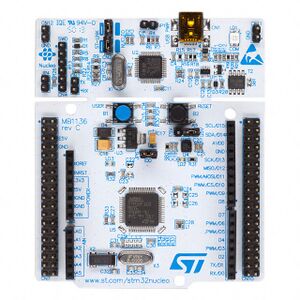Getting Started with STM32
Although this getting started class will work well for many of the STM32 processors and boards, we will focus on the NUCLEO-F103RB board with its STM32-F103RB processor.

64-Pin NUCLEO Board
- Green LED, LD2, connected to PA5, illuminates when driven high
- Blue PushButton, B1, connects to PC13, grounding the signal when pressed
- 32,768Hz crystal oscillator, LSE, used for Real Time Clock (RTC)
- 8MHz HSE, is provided by the 8MHz crystal oscillator from the attached ST-Link, into PD0
- UART2 connects the target processor to the ST-Link, providing a USB COM port connection on the host computer. Uses PA2 for TX, and PA3 for RX.
- ST-Link connects to TCK (PA14), TMS (PA13)
Board: https://www.st.com/en/evaluation-tools/nucleo-f103rb.html
Manual: https://www.st.com/resource/en/user_manual/um1724-stm32-nucleo64-boards-mb1136-stmicroelectronics.pdf
Schematic: https://www.st.com/resource/en/schematic_pack/nucleo_64pins_sch.zip
Processor: STM32F103RBT6
* 128KB Flash * 20KB SRAM * 72MHz clock * Single-cycle multiplication and hardware division * 2.0 to 3.6 V application supply and I/Os * Within this part series, this is considered a "Medium-density device", and as such, has the following peripherals: * 3 USARTs * 3 16-bit timers * 2 SPIs, 2 I2Cs, USB, CAN, 1 PWM Timer, 2 ADCs Notes: "Low-density device" has fewer peripherals. "High-density device" has more peripherals.
printf()
The printf() function is commonly used for "C" programming to output formatted text to a terminal. This allows easy debugging in that variables, intermediate values, entering/leaving functions can be monitored and status displayed with the printf() stdio library function. The STM32 development environment provides an stdio printf() library function, but some "connecting glue" is required to provide the desired output. The printf() function calls _write() to perform an output function. See the _write() function in syscalls.c. This function was give the (weak) attribute, allowing the function to be over-written (without causing a warning or error message.) This default _write() function calls __io_putchar() to output one character at a time. Redefining either function to write characters to a serial port will produce a functioning printf().
Additional Resources:
Shawn Hymel - How to use printf() on stm32 Digikey Forum: Easily Use Printf On STM32